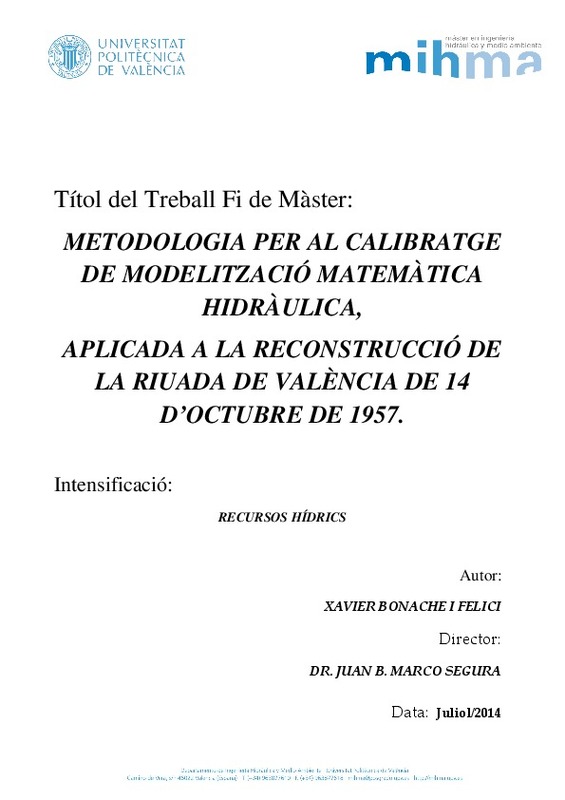|
Resumen:
|
[EN] Nowadays a large number of mathematical models for complex hydraulic flood studies are made, often without the support of a worth full process for the calibration and the validation. Circumstance often justified on ...[+]
[EN] Nowadays a large number of mathematical models for complex hydraulic flood studies are made, often without the support of a worth full process for the calibration and the validation. Circumstance often justified on the basis of the absence of data, tending to oversizing in order to stay in the best side of safety, but nevertheless with great uncertainty regarding the validity of the results obtained from simulation. Thus the aim of this work is to establish a methodology for hydraulic mathematical modelling calibration, applied to the case of the flood of Valencia in October 14, 1957. Methodology that highlight the relevance of: non-systematic information additions, complementary non-mathematical scientific tools, such the paleohidrology, hydrogeomorphology, or geoarcheoology , and others for support such GIS, remote sensing and photo interpretation, to proceed to the conceptualization of hydraulic behaviour scheme, previously to hydraulic mathematical modeling strictly. These processes of calibration and validation are essential and acquire high significance for the historic character of the special episode, and its transcendence in what it can contribute as recent extreme flash flood for understanding the hydrological and hydraulic processes in the lower Turia River basin. It therefore aims on the one hand try to estimate the order of magnitude of the flood and the phenomena that contributed to its gestation. And moreover determine the error of the fit between the modeling and the fact observed through the traces of the flood taken following the discovery of certain unpublished materials from the flood. On the one hand research conducted allows us to try to establish the order of magnitude of the event, the validation of the then estimated hydrograph, and the phenomena that contributed to its gestation. And moreover allows to determine the error of fit between modelling and fact observed through flood fingerprints extracted from the analysis of large amount of non-systematic information, and in particular of certain unpublished materials of the flood with great value arising in the process of documentary research. These processes of calibration and validation intrinsically linked, are essential and acquire maximum significance for the historical character of the extraordinary episode analysed, and its importance in what it can contribute as a recent extreme flood, for understanding the recent geomorphological, hydrologic and hydraulic processes of the river course at the lower Turia River basin.
(inglés)
[-]
[ES] En la actualidad se realizan un gran número de complejas modelizaciones matemáticas hidráulicas para estudios de inundabilidad, a menudo sin el apoyo de un proceso de calibración y validación de peso. Circunstancia a ...[+]
[ES] En la actualidad se realizan un gran número de complejas modelizaciones matemáticas hidráulicas para estudios de inundabilidad, a menudo sin el apoyo de un proceso de calibración y validación de peso. Circunstancia a menudo justificada en base a la no existencia de datos, tendiendo al sobredimensionamiento para quedarse en el mejor de los casos del lado de la seguridad, pero a pesar de ello con gran incertidumbre por lo que respecta a la validez de los resultados obtenidos de la simulación. Así pues el objetivo de este trabajo es establecer una metodología de calibración de modelización matemática hidráulica, aplicada a la reconstrucción de la riada de Valencia de 14 de octubre de 1957. Metodología que viene a destacar la relevancia de la incorporación de información no sistemática, de herramientas científicas no matemáticas complementarias como la paleohidrología, la hidrogeomorfología, la o geoarqueología, y otras de apoyo como son los SIG, la teledetección y la fotointerpretación, para proceder a la conceptualización del esquema de comportamiento hidráulico de manera previa a la modelización matemática hidráulica estricta.. Por un lado la investigación llevada a cabo nos permite tratar de establecer el orden de magnitud del evento, con la validación del hidrograma de avenida estimado en su momento, y los fenómenos que concurrieron en su gestación. Y por otra parte poder determinar el error del ajuste entre la modelización y el suceso observado a través de las huellas de la avenida extraídas del análisis de gran cantidad de INS, y en particular de ciertos materiales inéditos de la inundación de gran valor surgidos en el proceso de recopilación documental. Los procesos de calibración y validación intrínsecamente ligados, resultan fundamentales y adquieren máxima significación por el carácter histórico del episodio extraordinario analizado, y por su trascendencia en lo que pueda aportar, como avenida extrema reciente, para el conocimiento de los procesos geomorfológicos, hidrológicos e hidráulicos del curso fluvial del Turia en su cuenca baja.
[-]
|






